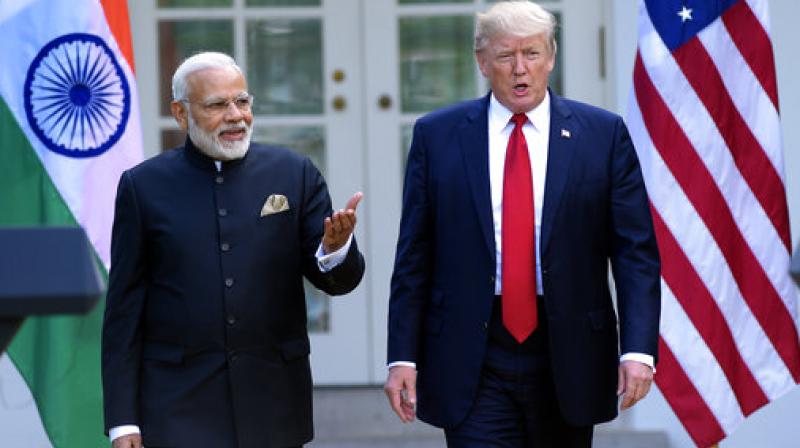After Modi-Trump meet, an uphill road lies ahead

Prime Minister Narendra Modi’s summit meeting with US President Donald Trump went off nicely on Monday. First Lady Melania’s presence at the South Portico of White House, despite
Mr Modi being single, and the attendance at the press interaction by daughter Ivanka, her husband Jared Kushner, vice-president Mike Pence and senior Cabinet members signified American hospitality at its fullest.
Mutually laudatory statements at the press meet set the scene for the India-US joint statement. The US state department’s move to separately notify that it had designated Syed Sallahuddin, leader of the already-proscribed terrorist organisation Hizbul Mujahideen, as an international terrorist gave India boasting rights about the US pillorying Pakistan, which in the past has simply worked past such listings by reinventing groups or changing their modus operandi.
Prime Minister Modi basically aimed to assess where President Trump stood on the US consensus, over the two earlier presidencies of George W. Bush and Barack Obama, that an economically and militarily stronger India was in the American interest and an essential counterweight to an assertive China, increasingly contemptuous of the global security order and elements of international law. The US withdrawal from the Trans-Pacific Partnership, its cynical assessment of Nato’s utility, broadsides at treaty allies about their refugee policies, etc. had raised concerns that
Mr Trump’s anti-globalisation, anti-immigration and isolationist rhetoric spelt a redrawing of America’s global role. Mr Trump’s participation in the Riyadh summit, leading to exacerbating divisions along Shia-Sunni and Arab-Iranian or Arab-Turkish lines, have fractured the Islamic world.
The joint statement addresses these concerns. It has five segments, the first one titled “Democratic Stalwarts in Indo-Pacific Region”. It revisits themes in the Vision Statement of 2015, issued during President Barack Obama’s India visit. The reference to democracy recalls the Bush era attempts at a Quadrilateral Dialogue between Australia, Japan, India and the US in 2006, on the sidelines of the Asean Regional Forum meeting. China had reacted angrily then, seeing it as a ploy to isolate it. There is a demand now for common principles of conduct, observance of international law, freedom of navigation, peaceful resolution of disputes and regional connectivity, while respecting sovereignty, environment and responsible debt-financing.
The clear reference is to China’s unilateral seizure and development of islands and military facilities in the South China Sea and its Belt and Road Initiative. The sovereignty argument espouses Indian objections to the China-Pakistan Economic Corridor (CPEC), transversing Gilgit-Baltistan, which India claims as its territory. The United States thus indicates its willingness for offshore balancing of China provided that the democracies of the Asia-Pacific region assume primary responsibility. This is Mr Trump’s version of the US as a 21st century global hegemon.
The second segment issues a “Call on other nations in the region to adhere to these principles”, the focus shifting to India’s western neighbourhood. The stated intent is to increase cooperation, consultation and “collaboration with partners in the Middle East”. Surprisingly, the Democratic People’s Republic of Korea (North Korea) figures here, when as a Chinese protégé it is best treated in the Indo-Pacific context. This part dissimulates differences between the Indian and US approaches. Mr Trump’s presence at the Riyadh summit exacerbated divisions in the Gulf, where the livelihood of six million Indians and the country’s trade and energy interests are at stake. India cannot endorse the US taking sides against Iran and Qatar and with Saudi Arabia and the UAE. It would be surprising if the US didn’t discuss Iran and try push India to boycott it. This has the potential to be a future irritant as Mr Trump’s regional vision is divisive and confrontational vis-à-vis the Shias.
The “Shoulder to Shoulder Against Terrorism” part of the statement is old hat, plus bells and whistles. The US asking Pakistan to check terrorists using its territory against neighbours primarily refers to Afghanistan. But with America’s own policy on Afghanistan being under review, the Indian perspective presented by Mr Modi might help to counter Pakistani sympathisers in the US administration. But sources in the US state department told the media that Washington does not see a “zero sum game” here. Empathising with India does not tantamount to declaring Pakistan a state that sponsors terror, as Pakistan figures in the Saudis’ Sunni alliance and is critical to the US endgame in Afghanistan.
Some paragraphs follow on strategic convergence and defence cooperation, including the sale of unarmed Sea Guardian drones only fit for surveillance, and the expanded “Malabar” naval exercises, besides lukewarm support for India’s aspiration to join the Nuclear Suppliers Group and a reformed UN Security Council. The last segment turns to “Increasing Free Trade and Fair Trade”, which hinges on Mr Trump’s core ideas. By conceding a comprehensive review of current commercial and economic links, India has bought some time but also accepted that currently “fairness” is moot.
The challenge will be to now tweak the regulations, seek co-production in India in exchange for market access to US companies and encourage Indian industry to adapt and innovate, seeking partners in Europe, Japan and the Republic of Korea, to survive in a Trumpian world. It will be an uphill haul.
President Trump pointed out that the Constitutions of both countries begin with “We the People”. But he omitted to note that the US First Amendment and Articles 15 and 19 of India’s Constitution safeguard freedom of faith, speech and a free press. President Trump gleefully added that he and
Mr Modi have around 30 million-plus followers each on Twitter. But both are economical in condemning attacks on their own people by those who share their faith or race. To be truly “democratic stalwarts”, both must show adherence to the values that they preach. Only then can America remain “Great” and India become so one day.

